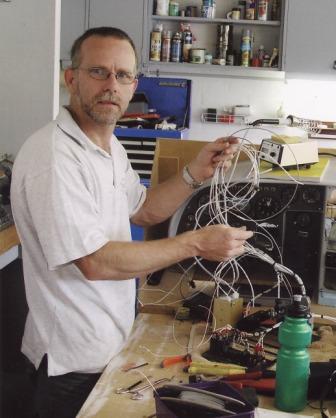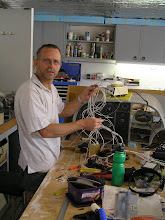Easter long weekend, great excuse to do a little more work. Last post was the upper deck of the engine cowl, this time I tackle the lower half.
This first shot shows the upper deck repositioned in the mould with double sided tape. The edges were taped to ensure the joggle would release, I will be laying 1.5" over the top deck edge. I found this stretchy duct tape shrank away from the corners so I ended up replacing it with masking tape.
This first shot shows the upper deck repositioned in the mould with double sided tape. The edges were taped to ensure the joggle would release, I will be laying 1.5" over the top deck edge. I found this stretchy duct tape shrank away from the corners so I ended up replacing it with masking tape.

I decided to leave the 3rd mould part off to begin with to make it easier to reach the nose area. This proved to be a good decision and ensured a good layup in this crucial area. Note I have covered with peel-ply to assist with bonding in the next process.

All the materials ready to lay the outer skin ... fine layer of glass to start followed by a single layer of 200gsm CF (45' biased), peel ply, bleeder (vac bag not shown).

Ready to lay up the outer skin.

Outer skin done (sorry, no shots of the vacuum process this time). Note the joggle being formed in place.

Same as last time, marking up for the 3mm foam core-mat. The circle is where I will make a cutout for the carby ram air scoop and will be hardened with CF only (4 layers). The tombstone shape will be a cutout for the nose gear leg.

This foam is quite dense and very rigid but can be moulded slightly by applying heat, as seen here.

Here the foam bonded in with a micro slurry. I did this the same way as last time, weighed down with damp sand over a plastic sheet. Also as before I have left 3" around the edges to harden them in preparation for the fixings. These will have a total of 4 layers of 200gsm when finished.

The end result ... gorgeous ... weighing in at 2.9kg for a total so far of 4.7kg. With a little more trimming to do and the addition of the ram air scoop I'm right on my 5kg target. Note the slight damage demoulding it. Actually there were 2 scares getting it out of the mould, the second was that, with the small round air inlets, it didn't want to let go of the nose mould. Remembered a trick a wise old gent told me and let it soak in water for a few hours ... little more persuasion and out she popped.

This shot shows how well the joggle is formed and those pesky round inlets.

The joggle trimmed up, I will be using a piano hinge along the sides and just one screw each between the inlets and the spinner. This CF sandwich method sure is stiff when finished.




No comments:
Post a Comment